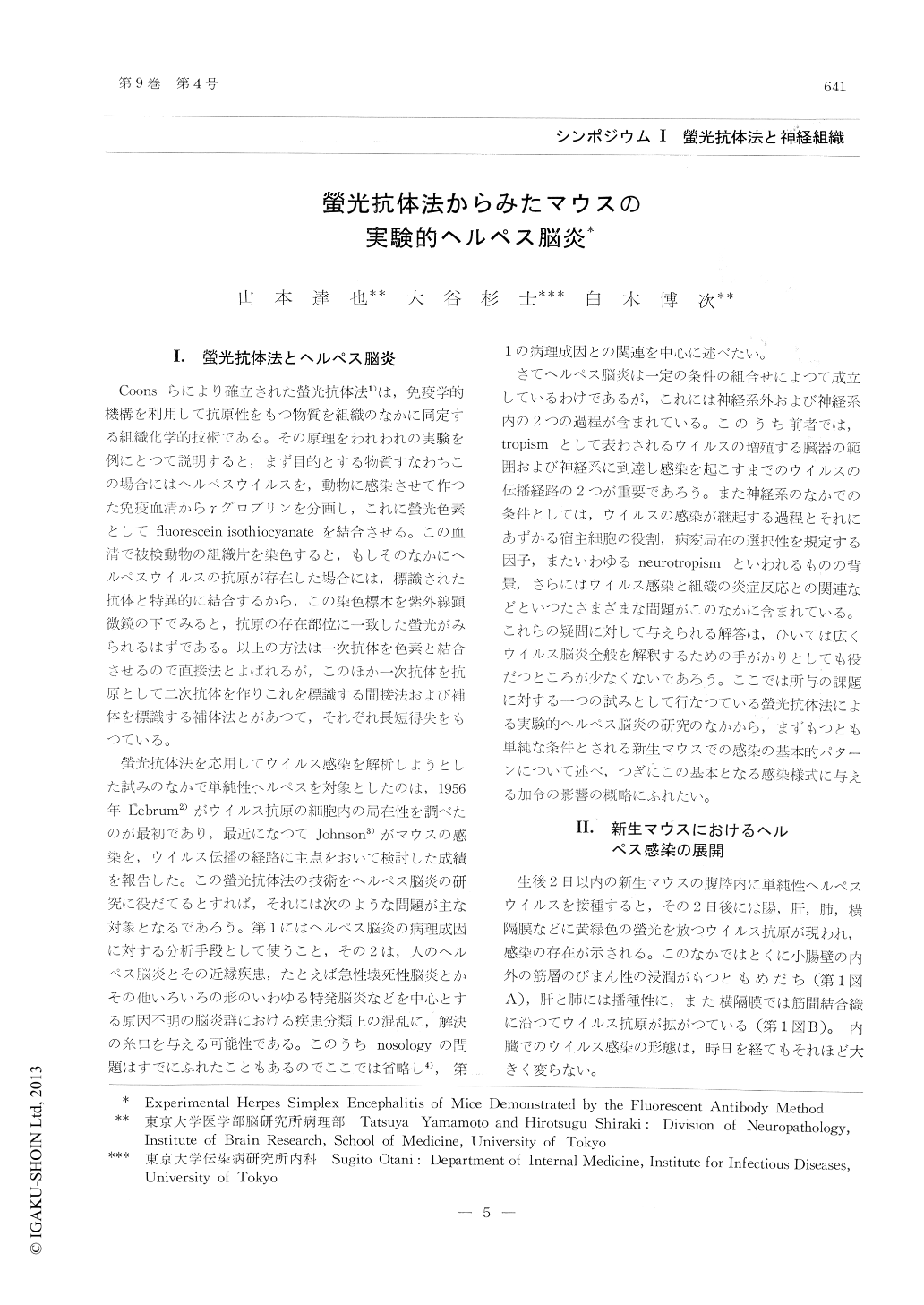Japanese
English
- 有料閲覧
- Abstract 文献概要
- 1ページ目 Look Inside
I.螢光抗体法とヘルペス脳炎
Coonsらにより確立された螢光抗体法1)は,免疫学的機構を利用して抗原性をもつ物質を組織のなかに同定する組織化学的技術である。その原理をわれわれの実験を例にとつて説明すると,まず目的とする物質すなわちこの場合にはヘルペスウイルスを,動物に感染させて作つた免疫血清からγグロブリンを分画し,これに螢光色素としてfluorescein isothiocyanateを結合させる。この血清で被検動物の組織片を染色すると,もしそのなかにヘルペスウイルスの抗原が存在した場合には,標識された抗体と特異的に結合するから,この染色標本を紫外線顕微鏡の下でみると,抗原の存在部位に一致した螢光がみられるはずである。以上の方法は一次抗体を色素と結合させるので直接法とよばれるが,このほか一次抗体を抗原として二次抗体を作りこれを標識する間接法および補体を標識する補体法とがあつて,それぞれ長短得失をもつている。
螢光抗体法を応用してウイルス感染を解析しようとした試みのなかで単純性ヘルペスを対象としたのは,1956年Lebrum2)がウイルス抗原の細胞内の局在性を調べたのが最初であり,最近になつてJohnson3)がマウスの感染を,ウィルス伝播の経路に主点をおいて検討した成績を報告した。この螢光抗体法の技術をヘルペス脳炎の研究に役だてるとすれば,それには次のような問題が主な対象となるであろう。
The pattern of infection in experimental herpes simplex encephalitis with special regard to the ageing effect was investigated using the fluorescent antibody technique. The findings obtained in newborn mice inoculated intraperitoneally with herpes simplex virus were summarized as follows.1) The propagation of herpes virus to the central nervous system was brought about through the fol-lowing two ways; hematogenous route producing the cerebral and cerebellar lesions and neural one responsible for an infection of the spinal cord. 2) Nerve cells, astrocytes and Schwann cells were the main hosts of the nervous system infection in which the virus antigen were exclusively localized in their cytoplasm. 3) Among viscera, the gas-trointestine, lung and liver were most frequently affected. The ageing process of mice caused a characteristic change of the above-mentioned pat-tern of infection. 1) The nervous system and digestive tracts were the major sites of herpetic infection after a gradual reduction of the sus-ceptibility of other viscera. 2) The vulnerability of the nervous regions characterized by hematoge-nous route, i.e. the cerebral hemisphere and cere-bellum, increased in parallel with a certain topo-graphical selectivity of lesions. 3) The peripheral nervous system such as the sympathetic nerve fiber plexus twined around blood vessels and the spinal nerve was extensively infected. 4) The steep fall of organ susceptibility to herpes virus occurred about three weeks after birth.

Copyright © 1965, Igaku-Shoin Ltd. All rights reserved.


